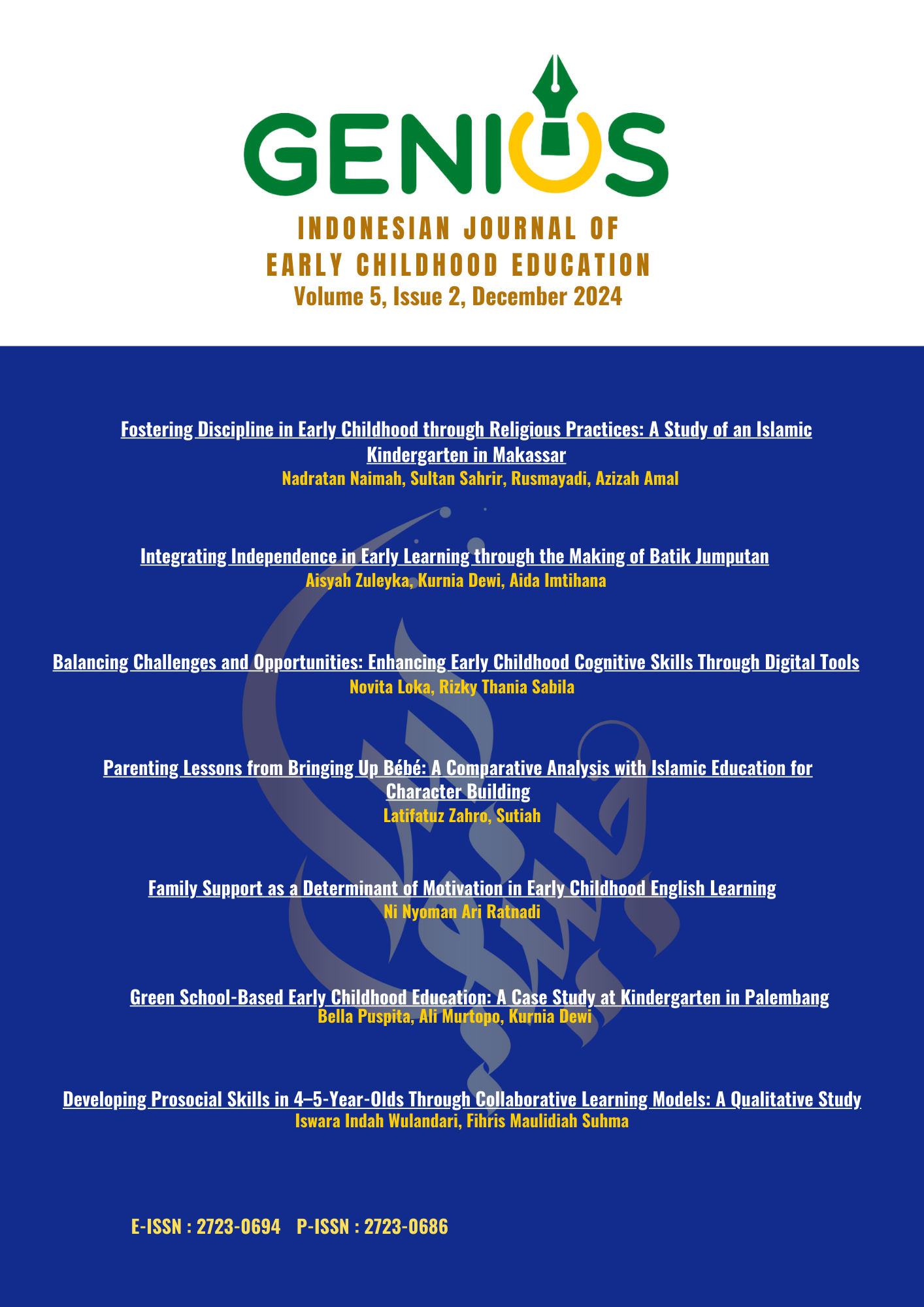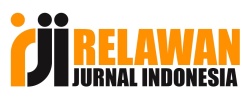Integrating Independence in Early Learning through the Making of Batik Jumputan
DOI:
https://doi.org/10.35719/gns.v5i2.183Keywords:
Merdeka Curriculum, character development, early childhood educationAbstract
This study examines integrating the independence dimension within the Pancasila Student Profile Project through the culturally enriching activity of batik-making, specifically Jumputan Batik, in Indonesia's Merdeka Curriculum. While using a qualitative phenomenological approach, data were collected through observations, interviews, and documentation involving principals, teachers, and students in early childhood education settings. The findings reveal that children demonstrated notable growth in independence, creativity, and resilience, mainly through hands-on activities. The structured project emphasized planning, execution, and evaluation, allowing children to practice self-reliance, adapt to challenges, and collaborate with peers. This study provides actionable insights for educators and policymakers, offering strategies to address identified challenges and enhance the effectiveness of character-building initiatives like the Pancasila Student Profile Project.
References
Ardial. (2014). Paradigma dan Model Penelitian Komunikasi. Bumi Aksara.
Atamanchuk, N., Yalanska, S., & Tur, O. (2020). Preschool Children’s Creative Development Of Practical Art Methods. PSYCHOLOGICAL JOURNAL, 6(10), 17–28. https://doi.org/https://doi.org/10.31108/1.2020.6.10.2
Atika, P. M., Masitoh, S., & Wahyudi, A. (2019). Creating Jumputan Batik with Active Learning Methods of Small Group Type for Students With Intellectual Disabilities. 3rd International Conference on Special Education (ICSE 2019).
Cerino, A. (2023). The importance of recognizing and promoting independence in young children: the role of the environment and the Danish forest school approach. Education 3-13, 51(4), 685–694. https://doi.org/10.1080/03004279.2021.2000468
Changwei Wang. (2022). The role of physical activity is to promote the thinking skills and emotional behavior of preschool children. Psicologia, Reflexao e Critica?: Revista Semestral Do Departamento de Psicologia Da UFRGS, 35(1), 1–8. https://doi.org/https://doi.org/10.1186/s41155-022-00223-1
Creswell, J. W. (2015). Penelitian Kualitatif dan Desain Riset?: Memilih di Antara Lima Pendekatan (A. B. Lazuardi (Trans.)). Pustaka Pelajar.
Fadlillah, M., Wahab, R., & Ayriza, Y. (2020). Understanding the Experience of Early Childhood Education Teachers in Teaching and Training Student Independence at School. The Qualitative Report, 25(6), 1461–1472. https://doi.org/https://doi.org/10.46743/2160-3715/2020.4163
Furu, A.-C., Chan, A., Larsson, J., Engdahl, I., Klaus, S., Navarrete, A. M., & Niska?, B. (2023). Promoting Resilience in Early Childhood Education and Care to Prepare Children for a World of Change: A Critical Analysis of National and International Policy Documents. Children, 10(4), 716. https://doi.org/https://doi.org/10.3390/children10040716
Izzah, N., & Pamungkas, J. (2024). The Excellence of Batik Art: Exploring the Impact of Batik Jumputan on Fine Motor Skills in Early Childhood Education. International Journal of Social Science and Human Research, 7(01). https://doi.org/https://doi.org/10.47191/ijsshr/v7-i01-97
Julaeha, S. (2019). Problematika Kurikulum dan Pembelajaran Pendidikan Karakter. Jurnal Penelitian Pendidikan Islam, 7(2), 157–182. https://doi.org/https://doi.org/10.36667/jppi.v7i2.367
Kahfi, A. (2022). Implementasi Profil Pelajar Pancasila dan Implikasinya Terhadap Karakter Siswa di Sekolah. Dirasah: Jurnal Pemikiran Dan Pendidikan Dasar Islam, 5(2), 138–151. https://doi.org/http://dx.doi.org/10.51476/dirasah.v5i2.402
Marsh, J. (2019). Makerspaces in the Early Years: Enhancing Digital Literacy and Creativity. In Exploring Key Issues in Early Childhood and Technology. Routledge.
Marsh, J., Wood, E., Chesworth, L., Nisha, B., Nutbrown, B., & Olney, B. (2019). Makerspaces in early childhood education: Principles of pedagogy and practice. Mind, Culture, and Activity, 26(3), 221–233. https://doi.org/10.1080/10749039.2019.1655651
Miles, M. B., Huberman, A. M., & Saldana, J. (2014). Qualitative Data Analysis: A Methods Sourcebook (3rd ed.). Sage Publications.
Munastiwi, E. (2023). Merdeka Belajar: Solution for Developing Creativity and Independence in Early Childhood Era of the Industrial Revolution 4.0. Jurnal Pendidikan Indonesia, 12(4), 615–626. https://doi.org/https://doi.org/10.23887/jpiundiksha.v12i4.61500
Musbikin, I. (2019). Penguatan Pendidikan Karakter: Referensi pembelajaran Untuk Guru dan Siswa SMA/MA. Nusa Media.
Mustaqim, & Wahib, A. (2003). Psikologi Pendidikan. Rineka Cipta.
Pillay, J. (2023). Psychological, social, and physical ecologies for child resilience: a South African perspective. Frontiers in Psychology, 14. https://doi.org/https://doi.org/10.3389/fpsyg.2023.1190297
Rahayu, S., Wahyuni, T., Imroatun, I., & Niputih, T. (2024). Introduction of Batik Jumputan for The Growth of Creative Thinking in Rural Preschools in Indonesia. BOCAH: Borneo Early Childhood Education and Humanity Journal, 3(2), 63–72. https://doi.org/https://doi.org/10.21093/bocah.v3i2.8273
Retnowati, Y. (2021). Pola komunikasi dan kemandirian anak. Mevlana Publishing.
Reynolds, A. J., Lee, S., Eales, L., Varshney, N., & Smerillo, N. (2022). Parental Involvement and Engagement in Early Education Contribute to Children’s Success and Well-Being. In K. L. Bierman & S. M. Sheridan (Eds.), Family-School Partnerships During the Early School Years (pp. 91–111). Springer International Publishing. https://doi.org/10.1007/978-3-030-74617-9_6
Rizal, M., Najmuddin, Iqbal, M., Zahriyanti, & Elfiadi. (2022). Kompetensi Guru PAUD dalam Mengimplementasikan Profil Pelajar Pancasila di Sekolah Penggerak. Jurnal Obsesi?: Jurnal Pendidikan Anak Usia Dini, 6(6), 6924–6939. https://doi.org/https://doi.org/10.31004/obsesi.v6i6.3415
Rozi, F., Widat, F., Saleha, L., Zainiyah, A., & Aisyah, S. N. (2022). The “Aku Bisa” Program; Efforts to Train Early Childhood Independence. Jurnal Obsesi?: Jurnal Pendidikan Anak Usia Dini, 6(4), 3218–3231. https://doi.org/https://doi.org/10.31004/obsesi.v6i4.2067
Sanusi, A. (2012). Metodologi Penelitian Bisnis. Salemba Empat.
Sari, D. R., & Rasyidah, A. Z. (2019). Peran Orang Tua Pada Kemandirian Anak Usia Dini. Jurnal Pendidikan?: Early Childhood, 3(1), 1–12. https://doi.org/https://doi.org/10.35568/earlychildhood.v3i1.441
Sugiyono. (2022). Metode Penelitian Kuantitatif, Kualitatif dan R&D. Alfabeta.
Ulandari, S., & Rapita, D. D. (2023). Implementasi Proyek Penguatan Profil Pelajar Pancasila sebagai Upaya Menguatkan Karakter Peserta Didik. Jurnal Moral Kemasyarakatan, 8(2), 116–132. https://doi.org/https://doi.org/10.21067/jmk.v8i2.8309
Wiyani, N. A. (2023). Implementasi proyek penguatan profil pelajar pancasila dalam kurikulum merdeka di lembaga paud. Jurnal Pendidikan Anak, 12(1), 23–35. https://doi.org/http://dx.doi.org/10.21831/jpa.v12i1.57879
Wulida, Y., & Sapriya. (2024). Efforts to Improve Learners’ Creativity Through the Art Practice of Making Batik Jumputan at Elementary School. The Asian Conference on the Social Sciences (ACSS).
Xiang, S., Yang, W., & Yeter, I. H. (2023). Making a Makerspace for children: A mixed-methods study in Chinese kindergartens. International Journal of Child-Computer Interaction, 36, 100583. https://doi.org/https://doi.org/10.1016/j.ijcci.2023.100583
Downloads
Published
How to Cite
Issue
Section
License
Copyright (c) 2024 Aisyah Zuleyka, Kurnia Dewi, Aida Imtihana

This work is licensed under a Creative Commons Attribution-ShareAlike 4.0 International License.
All articles published in GENIUS: Indonesian Journal of Early Childhood Education are licensed under a Creative Commons Attribution-ShareAlike 4.0 International License (CC BY-SA 4.0).
This license allows others to share (copy and redistribute) and adapt (remix, transform, and build upon) the material for any purpose, even commercially, as long as appropriate credit is given to the original author(s) and the source, and any derivative works are distributed under the same license as the original.












